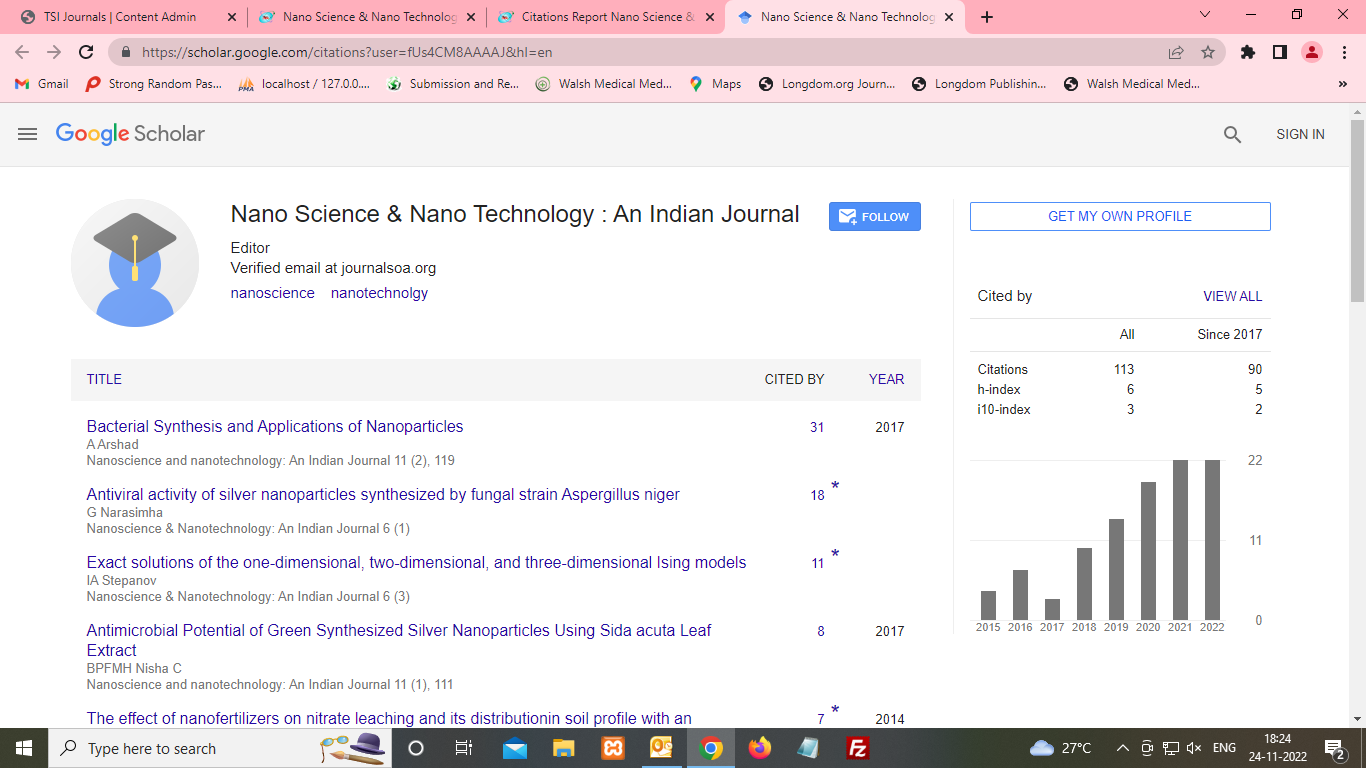Current opinion
, Volume: 16( 5) DOI: doi: 10.37532/ 0974- 7494.2022.16(5).163Nanotechnology in Food and Agriculture: Current Applications
- *Correspondence:
- Azra Hicks Nanoscience & Nanotechnology: An Indian Journal, UK E-mail: hicksazra@gmail.com
Received: Sep 3, 2022, Manuscript No. tsnsnt-22-80161; Editor assigned: Sep 5, 2022, PreQC No tsnsnt-22-80161 (PQ); Reviewed: Sep 17, 2022, QC No. tsnsnt-22-80161 (Q); Revised: Sep 20, 2022, Manuscript No. tsnsnt-22-80161 (R); Published: Sep 27, 2022, doi: 10.37532/ 0974- 7494.2022.16(5).163
Citation: Hicks A. Nanotechnology in Food and Agriculture: Current Applications. Nano Tech Nano Sci Ind J. 2022; 16(5):163. ©2022 Trade Science Inc.
Abstract
Agri-food nanotechnology is expected to become a major economic force soon. Nanotechnology is one of the most crucial tools in modern agriculture. The sustainability and protection of agriculturally produced foods, including crops for human consumption and animal nutrition, are the subject of agri-food topics. To increase crop yield and to cut down on the usage of pesticides, nanotechnology offers novel agrochemical agents and new delivery systems.
Introduction
Agri-food nanotechnology is expected to become a major economic force soon. Nanotechnology is one of the most crucial tools in modern agriculture. The sustainability and protection of agriculturally produced foods, including crops for human consumption and animal nutrition, are the subject of agri-food topics. To increase crop yield and to cut down on the usage of pesticides, nanotechnology offers novel agrochemical agents and new delivery systems.
The use of matter at the atomic, molecular, and supramolecular levels for industrial purposes is known as nanotechnology, also abbreviated as nanotech. Nanotechnology is a technique for creating materials with at least one size between 1 and 100 nanometres. Nanotechnology, as it is naturally defined, spans a wide range of scientific disciplines, such as surface sciences, organic chemistry, molecular biology, semiconductor physics, energy storage, mechanical engineering, microfabrication, and molecular technique. If 50% or more of the particles in the size distribution have one or more external dimensions that are in the range of 1-100 nm, the term "nanomaterial" refers to a natural, incidental, or artificial material that contains a particle in an unbound state, as a mix, or as an agglomerate.
Layered materials, such as graphene, thin films, or surface coatings, only have one dimension at the nanoscale. Nanowire and nanotube are examples of two-dimensional nanoscale materials. Nanotechnology can boost agricultural output, and Nano formulations are one of its applications. Animal health, animal husbandry, poultry production, and postharvest management. Nano sensors and biosensors. Dwarf devices. Plant disease diagnosis. Typically, pesticides are used in agriculture to increase crop output and effectiveness. Nano pesticides are one of the replacement strategies being used to address the problems with non-Nano pesticides. Numerous chemicals that fall within the broad category of Nano pesticides are already available on the market. Such Nano formulations mix a variety of surfactants, polymers, and metal nanoparticles in the nanometre size range rather than being conceived of as a single entity. One of the constraints on the development of crop protection agents is the lack of water solubility. In controlled-release (CR) formulations of imidacloprid (1-(6 chloro-3-pyridinyl methyl)-N-nitro imidazolidin-2-ylideneamine), made from polyethylene glycol and various aliphatic diacids using encapsulation techniques, effective pest management in various crops has been achieved.42 Nanomaterials serve equally as additives (mostly for controlled release) and active constituents. Both a commercial formulation and the prepared CR formulations were tested for their bioefficacy against two of the most significant pests of soybean, the white fly (Bemisia tabaci Gennadius) and the stem fly (Melanagromyza sojae Zehntmer). The majority of imidacloprid's CR formulations performed better at controlling pests than its commercial formulations, but among them, a formulation based on poly (poly(oxyethylene-1000)-oxy suberoyl) amphiphilic polymer outperformed the others at reducing stem fly incidence and Yellow Mosaic Virus transmission by white fly.
In order to improve hydrophobic pesticides' dispersion in liquid media and enable a controlled release of the active ingredient, microencapsulation has been used as a versatile tool. It has been reported to use polymers in the production of nanoparticles. With the promise of better taste, texture, and consistency, nanostructured food ingredients are being developed. The extent of food waste caused by microbial infestation is being reduced and the shelf-life of various food materials is being extended thanks to nanotechnology. In order to deliver food additives in food products without affecting their fundamental morphology, nano carriers are now being used as delivery systems.
Applications of nanotechnology in agriculture include
1. Nano formulations of agrochemicals for applying pesticides and fertilisers for crop improvement;
2. The use of Nano sensors and Nano biosensors in crop protection for the detection of diseases and agrochemical residues
3. Nano devices for plant genetic engineering
4. Plant disease diagnostics
5. Animal health, animal breeding, poultry production 6. Postharvest manufacturing.
Conclusion
Over the previous years, the understanding of the usage of buildings on the nm scale in the food industry is rising as a result, interest in and activity in this research area have dramatically increase focused. As nano nanotechnology develops, gadgets or Smaller and more plentiful materials that supported this technology applications of sensitive nanotechnology are now being investigation, testing, testing, and occasionally use all aspects of food technology, from agriculture to processing, packaging, and nutritional supplements." Unique chemical, physical, and mechanical properties agricultural waste products have received interest in recent years given the availability of renewable raw materials.
In addition to enhancing the fertilisation process, plant growth regulators, insecticides transport of active matter to the preferred goal sites, wastewater treatment, and vitamin absorption in plants, nanomaterials organised through green and inexperienced strategies may also boost agriculture's capacity.

